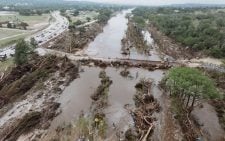WHO report shows global drop in deaths from drowning

As the world continues to grapple with the effects of climate change including high rainfall patterns that result in floods, it is said that around the world about 30 people drown every hour.
Citizens from low- and middle-income countries where early warning systems and flood mitigation infrastructure are underdeveloped are more predisposed to drowning due to floods.
Additionally, people living in countries that experience heatwaves have an increased chance of drowning as they spend longer in and on the water to cool their bodies.
The World Health Organisation (WHO) says that the rate of drowning deaths among men is higher by two-folds than in women owing to their daredevil tendencies.
“The higher drowning rates among males are due to increased exposure to water and riskier behaviour such as swimming alone, drinking alcohol before swimming alone and boating,” WHO said in its first-ever report on drowning.
According to WHO young children are also at high risk of drowning due to an underdeveloped ability to assess risk, and lack of swimming and water safety skills especially when they are not accompanied or under the supervision of an adult.
“Children and young adults aged 0–29 years account for over half (57 per cent) of all drowning deaths. The highest drowning rates per population are among children aged 0–4 years,” the global health body reported.
WHO also noted that suffocating in water mostly affects poor and marginalised people as they collect the commodity for their subsistence use.
“Whether it be through the use of ponds, rivers or lakes for bathing and washing clothing, or using open wells for collecting water, the pattern of daily exposure in low- and middle-income countries brings a higher risk of drowning,” the report clarified.
United Nations data revealed that people whose way of life is based on waterbodies, such as fishermen and seafarers are also prone to drowning despite their years of experience.
“The United Nations Food and Agriculture Organisation (FAO) estimates that more than 32,000 fishers die while working every year. Climate change has aggravated the hazardous conditions under which most fishers work, as extreme weather and natural disasters become more prevalent and destructive,” WHO warned.
Unsafe vessels
The global health body explained that it is becoming extremely risky to travel on water, during dangerous weather conditions, especially in developing countries where the water transport sector is significantly less regulated than in high-income countries.
“Daily commuting often takes place on overcrowded and unsafe vessels, operated by staff who have not been trained to recognise hazardous conditions or perform high-seas navigation,” the organisation reported.
It cautioned water travellers that without appropriate safety equipment, drowning is inevitable when the worst happens.
WHO also observed that drowning has become more rampant among migrants and refugees as they flee from conflicts, political and economic instability and climate change.
“Many people resort to irregular channels for migration that are extremely hazardous, including across large expanses of water in treacherous conditions, often using overcrowded, unsafe vessels that lack safety equipment or are operated by untrained personnel,” WHO’s document read.
The health body cited the Missing Migrants Project by its sister agency International Organisation for Migration (IOM) estimates that more than 67,922 people have lost their lives during unsafe migration journeys since 2014 where slightly more than half 39,383 (57 per cent) are attributed to drowning.
Since 2000, the UN data showed that the global drowning death rate has fallen by 38 per cent, from 6.1 to 3.8 per 100,000 of the population. Despite the drop, deaths from drowning remain a preventable public health crisis.
“Every drowning death is one death too many, and millions of people remain at risk. This report contains crucial data for policy-making and recommendations for urgent action to save lives,” Tedros Adhanom Ghebreyesus, WHO Director-General said.
The decline in drowning-related deaths seen in the past two decades, the organisation observed, falls short of what is needed to meet the many Sustainable Development Goals (SDGs) to which drowning prevention contributes.
WHO pointed out that drowning deaths in the African region, which recorded the highest rate globally, fell by a mere 3 per cent compared to other regions like Europe which recorded a 68 per cent drop in drowning death rate between 2000 and 2021.
This, WHO expounded, may be as a result of national commitments to address the drowning issue within the African Region where only 15 per cent of countries had a national strategy for drowning prevention, compared to 45 per cent of countries in the European Region.
Despite death by drowning being preventable, WHO warned that more than 7.2 million people, mainly children, could die in water by 2050, if current trends continue. And while the organisation has provided drowning prevention interventions to its member states, about three in every 10 countries are yet to fully implement them.
Among the interventions included search-and-rescue services, implementation of community-based flood risk mitigation programmes, training bystanders in safe rescue and resuscitation, and integration of swimming and water safety training into the school curricula















